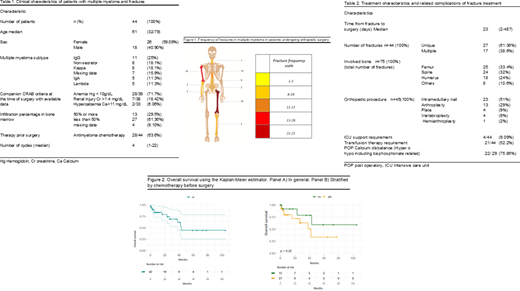Background
Multiple myeloma (MM) is an incurable and heterogeneous disease; often presents with skeletal-related events, including pathological fractures. Lytic bone disease is mediated mainly by dysregulation of interleukin 6 (IL-6), osteocalcin production, osteoblastic inhibition, osteoclast activation which prevents fracture healing. MM patients with fractures have a significantly higher risk of dying compared to those without fractures, highlighting the importance of preventing bone disease in MM. Usually, when it has manifested, it is necessary to provide adequate multidisciplinary treatment that could improve quality of life and survival.
Methods
Records of patients with MM and pathological fractures, requiring surgery were identified through National Cancer Institute of Colombia registry. A total of 799 MM records were reviewed; 10% of them required orthopedic surgery treatment. Thirty-six patients were excluded because loss of to follow up. A descriptive analysis of the clinical characteristics of the patients was carried out, as well as a bivariate analysis of the clinic and the outcomes, and finally, an analysis of overall survival of the entire sample using the Kaplan Meier method and with respect to the time of surgery before or after starting antimyeloma treatment.
Results
Forty-four patients with MM required surgery, since they had pathological fractures. Median age at diagnosis was 61 years (32-79), 26 were female and 18 were male patients. The most frequent MM subtype among these patients was the producer of immunoglobulin G (IgG) and the associated CRAB component, different from lithic lesions was anemia. A total of 75 fractures were confirmed in the 44 patients. The most frequent site of fractures was the femur, followed by spine and humerus. Twenty-five percent presented with two or more bone segments affected. Median number of days from fracture to surgery was 23 days (2-487). The orthopedic procedure that was mostly performed in the series was the placement of intramedullary nails. Postoperative complications included transfusions (47.72%), ICU requirement (9.09%), and electrolytic disbalances that required correction (9.09%). From the whole complete series, 63.3% of patients received chemotherapy prior to the surgical procedure with a median of 4 cycles. Twelve patients died corresponding to 27.9%, having found an early post-operative mortality in the first month of 4.54% and 12 months of 13.63%. There were no significant differences in survival with respect to the start of chemotherapy before or after surgery, but there was a trending for a better outcome in patients who did not receive preoperative chemotherapy.
Conclusions
Multiple myeloma remains as an incurable disease to date, frequently presenting skeletal-related events that affect quality of life and survival. There is a high risk of postoperative complications such as requiring intensive care, transfusions, and electrolyte disturbances in these patients. Despite not having found statistically significant differences regarding the start of chemotherapy; before or after the surgical procedure with respect to survival, improvement can be see it, when anti-myeloma therapy has not been started at the time of surgery. Prospective studies are required to elucidate whether there is benefit in delaying chemotherapy until after the patient is brought to fracture correction.
No relevant conflicts of interest to declare.
Author notes
Asterisk with author names denotes non-ASH members.


This feature is available to Subscribers Only
Sign In or Create an Account Close Modal